Sports in Afghanistan has played an important role in the culture of the country since the tenth century when Mongolian nomads traveled through the region. Sports has provided the inhabitants of the land with entertainment for generations, but it has not been uninterrupted. Since the beginning of the twentieth century Afghanistan has undergone a series of conflicts, both internal and foreign, which have altered Afghan culture. The Third Anglo-Afghan War between the British Empire and Afghanistan brought in western sports including football (soccer). Then, in 1978 and in the middle of the Cold War, a communist coup rose to power in Afghanistan among much infighting and opposition within the nation. One year later, to provide support for the weak communist government, the Soviet Union invaded Afghanistan and installed a Soviet-backed leader, causing the opposition towards to the government to increase. Soviet presence in Afghanistan lasted a decade before the Soviet Union pulled out of the country following the mujahideen, with support from the United States, China, and Saudi Arabia, fighting back against the Soviets. The last Soviet soldiers left Afghanistan in 1989 after over one million Afghan citizens were killed amidst the fighting and many millions more displaced. The removal of the Soviets from Afghanistan did not equate peace, however, as a civil war ensued until 1996, four years after President Najibullah, leader of the communist regime, was removed from power. Towards the end of the civil war, and to mark the end of the civil war, the Taliban seized control of Kabul, Afghanistan's capital, and implemented Sharia Law as its governmental framework. This meant that women were no longer allowed to work, all western ideals were expelled from the country, and punishments were much stricter than ever before, including amputations and being stoned to death. The Taliban remained in power until December 2001 after a US-led invasion led to the removal of the government and the implementation of a republic where citizens vote in leaders. During the time period of Taliban rule, sports were all but removed as a way of life for Afghan citizens and it has taken over a decade for sports to start growing once again. This does not mean that playing sports or even watching sports is easy, however, as there are still many ways that life in Afghanistan makes elements of culture difficult to participate in, something I will highlight towards the end of this post. First, though, I am going to go over all of the popular sports in Afghanistan, covering the history of each sport in the country, its domestic and international teams, the national successes, and be certain to cover the role of women in the sports.
General History of Sports in Afghanistan
- Between 900 and 1400 AD the national sport of modern day Afghanistan, Buzkashi, was introduced to the region by nomads from what is now Turkey and Mongolia
- In 1839, cricket is first played in Afghanistan by British soldiers during the First Anglo-Afghan War
- During the early 20th century, western sports including tennis and golf were introduced
- In 1936, Afghanistan competed at the Summer Olympics for the first time, not winning any medals
- In 2008, the nation won its first Olympic medal at the Beijing Summer Games, a bronze in Taekwondo
Popular Sports
- Cricket
- Football (soccer)
- Boxing
- Basketball
- Buzkashi (Afghanistan's national sport)
- Kite Fighting
- Tent-Pegging
Cricket
- Initially played on Afghan soil in 1839 by British soldiers during the First Anglo-Afghan War but it didn't take hold at that moment
- It took until the 1990's when Afghan refugees living in Pakistan, due to the civil war, began playing the sport and it quickly grew in popularity
- In 1995, the Afghanistan Cricket Federation (ACF) was formed among these refugees
- Cricket was banned when the Taliban rose to power in 1996 after refugees returned home, but it became an exception in 2000 even though all sports were banned
- In 2001, the ACF was elected as an affiliate member of the International Cricket Council (ICC) and in 2003, as an affiliate member of the Asian Cricket Council (ACC)
International Teams
- Men's Teams
- The Afghanistan Men's National Team began play only in 2008 and played in the 2009 Cricket World Cup Qualifier after rising through the ranks
- The team failed to qualify for the 2011 World Cup through the qualifier but did earn One-Day International status, allowing them to compete in the one-day form of cricket
- In February 2010, the national team secured a bid to the 2010 ICC World Twenty20 tournament, a different type of cricket
- In 2013, Afghanistan finished second in the World Cricket League Championship and qualified for the 2015 Cricket World Cup
- At the 2015 World Cup the team won its first Cricket World Cup match by beating Scotland
- Women's Teams
- The Afghanistan Women's National Team was formed in 2010 from a pool of players, mostly from the capital city of Kabul
- The team has yet to play at the international level after it was scheduled to participate in the 2011 ACC Women's Twenty20 competition but was forced to withdraw due to internal opposition to female sports
Domestic Competition
- Domestic cricket competition in Afghanistan initially started as a 25-over inter-provincial tournament which involved twenty-two provinces
- Since 2011, cricket in Afghanistan has been divided into five regions:
- Amo in the north
- Spin Ghar in the northeast at the border with Pakistan
- Band-e-Amir in the center near the capital, Kabul
- Mes Aynak in the southeast
- Boost in the southeast, centering on Kandahar
- Each region has a representative team that plays in all three cricket formats - One-Day, Twenty20, and Three-Day
- Currently, 32 of the 34 Afghan provinces have representative sides
Stadiums
- Although the Taliban is no longer in power in Afghanistan, it is still not overly safe to play home cricket matches in Afghanistan. Instead, they have played their home matches in Sri Lanka and the UAE in recent years.
- There are currently three cricket stadiums being constructed that could be used for international cricket matches:
- One in Jalalabad
- A national cricket stadium in Kabul
- One in Kandahar
- In 2010, it was announced that the Afghan government was planning to build a cricket stadium in each province to further grow the sport
World Rankings (Men's)
- 10th in One-Day International
- 9th in Twenty20
Best Players (All ranked in the ICC's top 100)
- Mohammad Shahzad, Mohammad Nabi, Noor Ali Zadran, Najibullah Zadran, Nowroz Mangal, Asghar Stanikzai
Football (Soccer)
- The Afghan Football Federation (AFF) was formed in 1933 and joined FIFA in 1948
- It played its first match against European opposition at the London Olympics in 1948, losing to Luxembourg
- When the Soviets invaded Afghanistan in 1979, football was put on the back-burner for more than two decades, until 2002, when it competed at the Asian Games in South Korea
- The national team recorded its first international victory in over twenty years in 2003 when they beat Kyrgyzstan in an Asian Cup qualifying match
International Teams
- Afghanistan National Men's Team
- Joined FIFA in 1948
- Joined the Asian Football Confederation (AFC) in 1954 as one of its founding members
- Played no international matches from 1984-2002 due to the Soviet invasion, the Afghan civil war, and the Taliban
- Started its FIFA World Cup campaign in 2003 and played in the 2006 World Cup qualifiers, losing both matches it played in
- They are still attempting to reach their first World Cup
- Best finishes
- Asian Games - 1951 (4th Place)
- South Asian Football Federation (SAFF) Championship - 2013 (Champions)
- AFC Challenge Cup - 2014 (4th Place)
- Current World Ranking: 145th
- Afghanistan National Women's Team
- Formed in 2007 by the Afghanistan National Olympic Committee mostly made up of girls from Kabul
- Played their first match against the International Security Assistance Force women's team in 2007, winning 5-0
- In 2008, they played in the second national tournament of Pakistan where they won their group and lost in the finals
- In 2010, the team appeared in its first major international tournament by playing in the SAFF Women's Championship in Bangladesh. They were eliminated without winning any games and earning just one point
- They won their first major international competition match in 2012 at the SAFF Women's Championship by beating Pakistan 4-0
- Best Finishes
- SAFF Women's Championship - 2012 (lost in the semi-finals)
- Currently unranked
Domestic Competitions
- Two men's leagues
- Kabul Premier League - Major Competition
- 12 teams
- Created in 2006
- Teams play each other once a season inside the country's major soccer stadium, Ghazi Stadium in Kabul
- Most success club - Ordu Fabul F.C. - 3 championships
- Most recent champion - Big Bear F.C. - 2013
- Afghan Premier League
- Founded in 2012
- 8 clubs
- Established to spread football throughout the provinces
- Most successful (and most recent champion) club - Shaheen Asmayee F.C. - 3 championships
- One Women's League
- Women Kabul League
- 17 teams, all from Kabul
Stadiums
- Ghazi Stadium in Kabul
- Kandahar Stadium in Kandahar
- Herat Stadium in Herat
- Balkh Stadium in Mazar-i-Sharif
- Ghazni Stadium in Ghazni
- Kunduz Stadium in Kunduz
- Lashkar Gah Stadium in Lashkar Gah
Boxing
- Boxing has grown quite a bit in popularity in recent seasons
- This is due to Hamid Rahimi
- Rahimi is an Afghan-born refugee who fled to Germany when the Taliban took over Afghanistan
- He has a 23-1 record with 11 knockouts
- Fought the first professional boxing match in Afghanistan's history on October 30, 2012 in Kabul between Rahimi and Tanzanian, Said Mbelwa
- Rahimi won the fight in the 7th round and won the WBO's Intercontinental middleweight belt
- Boxing has become a way to create peace in Afghanistan
- Female Boxing
- 12 women team currently makes up Afghanistan's female boxing team
- At one point, there were 25 women on the team, all who received a salary, even if just a small one
- The funding was provided by aid organization who have since dropped out, forcing Afghanistan's National Olympic Committee to take over control of the team. The problem is that the committee has little money for the women (not sure if this mean's that they are unwilling to spend much money on female sports or if they just don't have much money left over to spend)
- The women still get a location to train at, even if just a few times a week for an hour or two each day, their boxing gloves are provided, and transportation costs are sometimes covered
- Sadaf Rahimi, the best female boxer to develop in Afghanistan, was on a path to box at the 2012 Summer Olympics in London but the International Boxing Organization (IBO) ruled that she shouldn't box due to safety concerns. They feared that her facing bigger and better trained competition could put her at a health and safety risk
Basketball
- First played in Afghanistan in 1936
- First national basketball team was founded in 1966 by the Afghanistan National Olympic Committee
- Became a member of FIBA in 1968
- Tom Gouttierre became the first coach of the men's national team when he was in Afghanistan as an American Peace Corps Volunteer. He was given detailed and confidential instructions from John Wooden on how to run UCLA's zone press, the only other team outside of the Bruins who could run it.
- They defeated its first opponent when it beat the highly-favored Chinese team in 1970
- Men's National Team
- The team has yet to qualify for the Summer Olympics, World Championships, or FIBA Asia Championship
- Asian Games
- 1970-2002 - failed to qualify
- Finished 13th (best finish) in 2006 and 2010
- South Asian Games
- 1995-2004 - did not participate
- 2010 - won the tournament
- Current FIBA Ranking - 133rd
- Many of its national team members have played college basketball and live in the United States
- Women's National Team
- Started in 2001 by American troops who were in Afghanistan fighting against the Taliban
- They have not played any international matches and seek out competition throughout Afghanistan to play against
- Currently unranked by FIBA
Buzkashi
- The word "buzkashi" translates to goat-grabbing and is the national sport in Afghanistan
- Thought to have been brought to modern-day Afghanistan by the Turkic-Mongol people and is played widely throughout Northern Afghanistan
- Game is played when men ride on horses attempt to place a headless goat or calf carcass into the middle of a circle
- The matches get extremely competitive as there is only one carcass and many horseback riders
- Usually played on Fridays during winter
- The winner of each match wins a wide variety of prizes, often donated by one sponsor and can range from money to cars to clothing
- They will usually draw thousands of fans
- Buzkashi has survived through the decades, but just barely
- During the Soviet invasion, the Soviets stole and killed most of the horses used in Buzkashi
- Then, during the Taliban reign, when Buzkashi was forbidden, the Taliban members stole most of the high-quality horses and used them in battle, killing them through malnourishment
- After the Taliban were driven out by the American military and the influx of American money came into the country, national leaders became wealthy and were willing to spend their money to back Buzkashi players and purchased high-end horses for riders to use and they also paid to take care of the horses in the best way possible.
- Buzkashi is also played in Pakistan, Kyrgyzstan, Kazakhstan, Uzbekistan, Tajikistan, and Turkmenistan
Kite Fighting
- Very popular sport in the Middle East where people fly kites with a more abrasive string than normal and attempt to cut their opponents' strings with their strings
- Played in Autumn when winds are the strongest
- There is an injury risk, however, as people will often run across roofs of buildings attempting to chase after their downed kites and occasionally they fall off the buildings
- Kites have been flown in Afghanistan for more than 100 years
- Under Taliban rule kite fighting and kite flying were banned
Tent Pegging
- Has been played since at least the 4th century B.C.
- It was developed out of cavalry training exercises in order to develop the cavalier's ability to use the sword and lance while on horseback
- It is believed that it originated in India when cavalry riders were up against elephant-riding enemies. The cavalry attempted to stab the fleshy area behind an elephant's toenail that is highly sensitized, forcing the elephant to rise up on its fears, causing the rider to be thrown
- The name "tent pegging" comes from the early morning raids launched by the cavalry where they severed enemy's tent cords or uproot the tent pegs
- Popular in Austalia, India, Israel, Oman, Pakistan, South Africa, and the UK
- Governed by the International Tent Pegging Federation, which is headquartered in Oman
- Tent Pegging World Cup - first took place in 2014, won by South Africa
Game Rules
- Mounted horseman riding at a quick pace toward a target and carrying a sword or lance in an effort to pick up and carry away a small target, representing a tent peg
- Other Variations
- Ring Jousting - rider has to pass his sword or lance through a ring before piercing the target
- Lemon Sticking - rider attempts to stab a suspended lemon while passing by
- Quintain Tilting - rider charges a mannequin mounted on a swiveling or rocking pedestal
Struggles Facing Sports in Afghanistan
- The country is still recovering from the time when the Taliban was in charge
- Nation does not have the excess funding needed to back a solid sports culture at the professional or international levels. Because of that, many of their athletes have to live outside of Afghanistan and return to compete internationally.
- The view of women's roles in sports is still rather clouded and, because of that, female sports have struggle to take off.
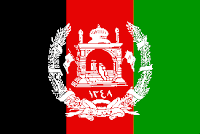

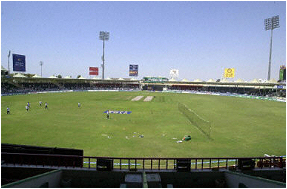
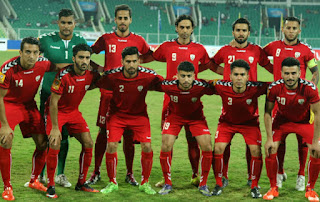


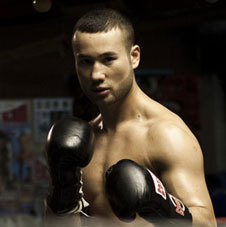
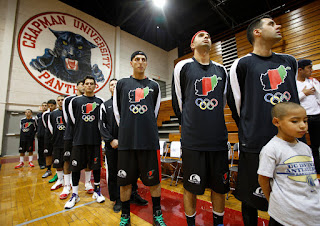
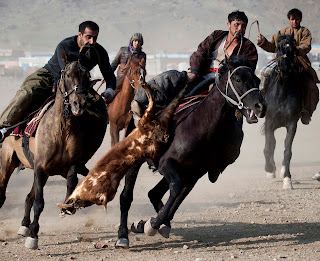

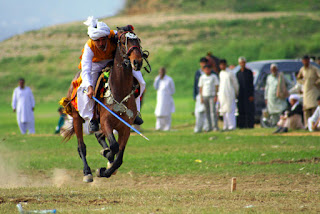
No comments:
Post a Comment